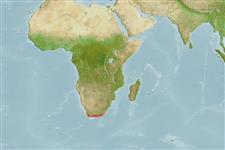Environment: milieu / climate zone / depth range / distribution range
Ecología
marino bentopelágico; rango de profundidad 20 - 200 m (Ref. 3198). Subtropical; 32°S - 35°S
Western Indian Ocean: Natal to Table Bay in South Africa.
Length at first maturity / Tamaño / Peso / Age
Maturity: Lm 29.5, range 23 - 29.7 cm
Max length : 90.0 cm TL macho / no sexado; (Ref. 3507); common length : 60.0 cm TL macho / no sexado; (Ref. 3507); peso máximo publicado: 3.5 kg (Ref. ); edad máxima reportada: 27 años (Ref. 50711)
Espinas dorsales (total): 12; Radios blandos dorsales (total): 10; Espinas anales 3; Radios blandos anales: 8
An important food fish. Adults feed mainly on fish, crustaceans and cephalopods (Ref. 4350). Spawn mainly during summer (Ref. 4350). Sometimes undertake large-scale migrations (Ref. 4350).
Bauchot, M.-L. and M.M. Smith, 1984. Sparidae. In W. Fischer and G. Bianchi (eds.) FAO species identification sheets for fishery purposes. Western Indian Ocean (Fishing Area 51). volume 4. [var. pag.] FAO, Rome. (Ref. 3507)
IUCN Red List Status (Ref. 130435)
Threat to humans
Harmless
Human uses
Pesquerías: escaso valor comercial; pesca deportiva: si
Más información
ReferenciasAcuiculturaPerfil de acuiculturaRazasGenéticaElectrophoresesheritabilidadEnfermedadesProcesamientoNutrientsMass conversion
ColaboradoresImágenesStamps, Coins Misc.SonidosCiguateraVelocidadTipo de nataciónSuperficie branquialOtolitosCerebrosVisión
Herramientas
Special reports
Download XML
Fuentes de Internet
Estimates based on models
Preferred temperature (Ref.
123201): 12.6 - 19.5, mean 16.3 °C (based on 19 cells).
Phylogenetic diversity index (Ref.
82804): PD
50 = 1.0000 [Uniqueness, from 0.5 = low to 2.0 = high].
Bayesian length-weight: a=0.01122 (0.00610 - 0.02063), b=3.03 (2.88 - 3.18), in cm total length, based on LWR estimates for this species & (Sub)family-body (Ref.
93245).
Nivel trófico (Ref.
69278): 3.5 ±0.2 se; based on size and trophs of closest relatives
Resiliencia (Ref.
120179): Bajo, población duplicada en un tiempo mínimo de 4.5-14 años (tm=5-6; tmax=27; K=0.07-0.08; Fec=11,000-1 million).
Prior r = 0.22, 95% CL = 0.15 - 0.33, Based on 2 stock assessments.
Fishing Vulnerability (Ref.
59153): High to very high vulnerability (68 of 100).
Climate Vulnerability (Ref.
125649): Very high vulnerability (84 of 100).
Nutrients (Ref.
124155): Calcium = 33.8 [19.0, 63.9] mg/100g; Iron = 0.793 [0.449, 1.403] mg/100g; Protein = 18.8 [17.8, 19.8] %; Omega3 = 0.327 [0.205, 0.530] g/100g; Selenium = 37.8 [16.7, 79.1] μg/100g; VitaminA = 22.8 [6.5, 83.4] μg/100g; Zinc = 0.691 [0.483, 0.968] mg/100g (wet weight);
